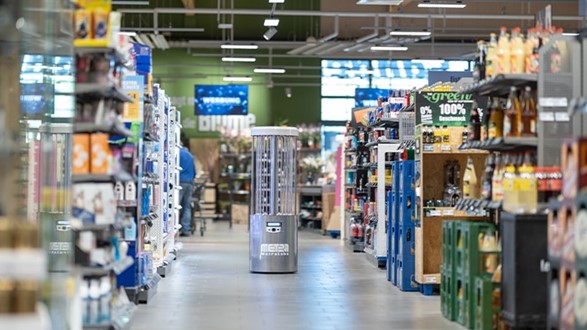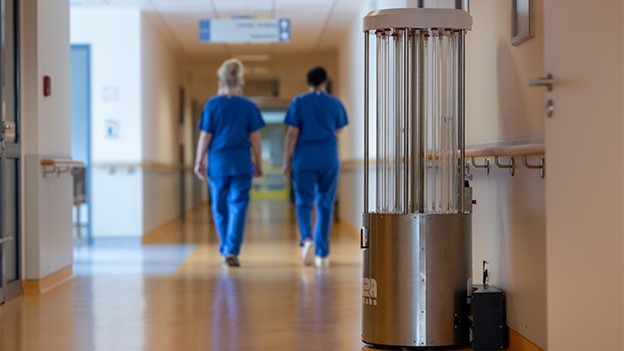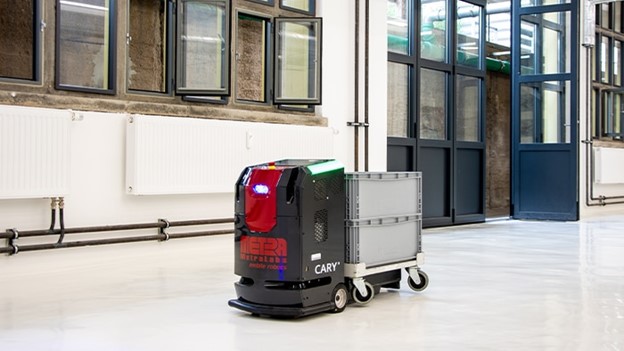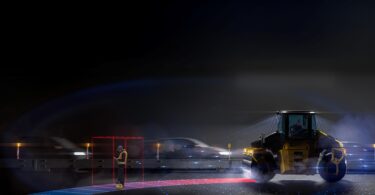SICK safety laser scanners and 2D LiDAR sensors enable mobile service robots from MetraLabs to move safely and efficiently
More and more, autonomous robots are shaping our everyday lives and routines. They mow lawns, vacuum living rooms, and clean windows. They can even work nonstop. These developments are incredible, but the products from MetraLabs can even exceed these tasks.
With many years of experience, the specialists in mobile service robotics offer robots for a wide variety of functions and applications: from inventory robots for retail to disinfection robotics to automated mini stackers for intralogistics. What do all these models have in common? They use safety laser scanners and 2D LiDAR sensors from SICK to move safely and efficiently, providing safe, successful services and an efficient flow of goods.
World travelers… multiplied by two
Since 2007, MetraLabs, based in the German city of Ilmenau, has put more than 300 robots on the market and set them in motion. Altogether, the robots have now traveled more than 100,000 km, which is two and a half times around the world!
“We’ve had very good experiences with SICK,” said Sabrina Greul-Nothnagel, who is responsible for the Industry and Health Care Division at MetraLabs. “The quality and technology are very impressive, and there is simply nothing comparable on the market in terms of safety technology.”
This is the reason why they have counted on SICK since the beginning. The combination of quality and innovation has built a strong foundation for moving the next kilometers together.
Mobile robotics versatility
As an example from the world of fashion, autonomous robot TORY finds its way between racks of clothes in a clothing store all on its own. Once it has been installed and given a map, it carries out automated inventory work with the help of RFID identification and can also be linked to the respective ERP system to automatically trigger orders. That alone is fascinating, but that’s not all – the TORY also works both at night and day. It isn’t worn out by foot traffic, small children, and objects such as shopping bags or boxes.
This is made possible by safety laser scanners of the S300 and TiM7xx series. They combine intelligent field evaluation and measurement data output in one device, so they can both record data about the presence of an object in a defined area as well as output exact measurement data of the scanned area. This is important, because it means that the safety laser scanners fulfill two of the most important requirements at the same time – safeguarding the driving movements for personal protection and simultaneous environment perception via non-secure measurement data for vehicle localization. In addition, the compact design of the TiM7xx makes it particularly well-suited for mobile platforms, automated guided vehicles (AGVs) and mobile service robots.
Disinfection provided by solar radiation
The wide range of tasks performed by mobile robotics demonstrate other applications. For example, disinfection robots have recently become the center of attention. This attention will continue even when the current need is no longer crucial because cleanliness and disinfection requirements go far beyond the health sector.
Mobile robots like the STERYBOT from MetraLabs make use of the principle of solar radiation. With the help of short-wave UV-C radiation, up to 99.99% of all viruses and bacteria are eliminated, while sensitive surfaces and medical equipment remain unharmed. The disinfection robot moves through the operating environment independently – with the help of safety laser scanners. The integrated functional safety and navigation software optimized over tens of thousands of kilometers ensure reliable orientation and avoidance of people and obstacles.
This ability to freely navigate makes the high disinfection rate and efficiency of the entire system superior when compared to robots that follow predefined routes. In addition to surface disinfection in hospitals and doctors’ offices, UV disinfection can also be used just as effectively for disinfecting supermarkets, shopping centers, hotels, offices, schools, or manufacturing facilities – a bright future indeed.
Mini-stacker – maximum safety
When it comes to production, the Ilmenau-based company also offers CARY, another mobile robot with safety laser scanners from SICK, for the wide range of requirements in production processes. An autonomous mini-stacker, it successfully fills a role in the transportation of loaded floor rollers – especially when loaded with very sensitive parts. The robots in this series can be easily integrated into existing intralogistics processes, either individually or in groups.
Exciting Mobile Research Developments
The examples from MetraLabs makes one thing clear: As diverse as the fields of application of mobile robotics have become, the interest of bright minds in this booming industry is just as strong.
“For years, we have been cooperating with Ilmenau University, among others, in research projects – the students’ interest in this is huge,” said Greul-Nothnagel.
This is an effort that SICK also supports to the best of its ability to keep curiosity and the spirit of research moving every day.
Want to learn more about how SICK can provide solutions for mobile robots?








